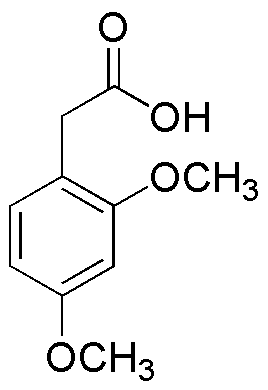2,4-Dimethoxyphenylacetic acid is widely utilized in research focused on:
- Pharmaceutical Development: This compound serves as a building block in the synthesis of various pharmaceuticals, particularly in the development of anti-inflammatory and analgesic drugs.
- Agricultural Chemistry: It is used in the formulation of herbicides, helping to enhance crop yield and manage weed populations effectively.
- Biochemical Research: Researchers employ this acid in studies related to enzyme inhibition and metabolic pathways, providing insights into biological processes.
- Cosmetic Formulations: The compound is incorporated into skincare products for its potential antioxidant properties, contributing to skin health and protection.
- Material Science: It is explored in the development of polymers and resins, offering improved durability and chemical resistance in various applications.
Información general
Propiedades
Seguridad y normativas
Aplicaciones
2,4-Dimethoxyphenylacetic acid is widely utilized in research focused on:
- Pharmaceutical Development: This compound serves as a building block in the synthesis of various pharmaceuticals, particularly in the development of anti-inflammatory and analgesic drugs.
- Agricultural Chemistry: It is used in the formulation of herbicides, helping to enhance crop yield and manage weed populations effectively.
- Biochemical Research: Researchers employ this acid in studies related to enzyme inhibition and metabolic pathways, providing insights into biological processes.
- Cosmetic Formulations: The compound is incorporated into skincare products for its potential antioxidant properties, contributing to skin health and protection.
- Material Science: It is explored in the development of polymers and resins, offering improved durability and chemical resistance in various applications.
Documentos
Hojas de datos de seguridad (HDS)
La SDS proporciona información de seguridad completa sobre la manipulación, el almacenamiento y la eliminación del producto.
Especificación del producto (PS)
La PS proporciona un desglose completo de las propiedades del producto, incluida la composición química, el estado físico, la pureza y los requisitos de almacenamiento. También detalla los rangos de calidad aceptables y las aplicaciones previstas del producto.
Certificados de análisis (COA)
Busque certificados de análisis (COA) ingresando el número de lote del producto. Los números de lote y de partida se pueden encontrar en la etiqueta de un producto después de las palabras "Lote" o "Lote".
Número de catálogo
Número de lote/lote
Certificados de origen (COO)
Este certificado de origen confirma el país en el que se fabricó el producto y también detalla los materiales y componentes utilizados en él y si se deriva de fuentes naturales, sintéticas u otras fuentes específicas. Este certificado puede ser necesario para cumplir con las normativas aduaneras, comerciales y regulatorias.
Número de catálogo
Número de lote/lote
Hojas de datos de seguridad (HDS)
La SDS proporciona información de seguridad completa sobre la manipulación, el almacenamiento y la eliminación del producto.
DownloadEspecificación del producto (PS)
La PS proporciona un desglose completo de las propiedades del producto, incluida la composición química, el estado físico, la pureza y los requisitos de almacenamiento. También detalla los rangos de calidad aceptables y las aplicaciones previstas del producto.
DownloadCertificados de análisis (COA)
Busque certificados de análisis (COA) ingresando el número de lote del producto. Los números de lote y de partida se pueden encontrar en la etiqueta de un producto después de las palabras "Lote" o "Lote".
Número de catálogo
Número de lote/lote
Certificados de origen (COO)
Este certificado de origen confirma el país en el que se fabricó el producto y también detalla los materiales y componentes utilizados en él y si se deriva de fuentes naturales, sintéticas u otras fuentes específicas. Este certificado puede ser necesario para cumplir con las normativas aduaneras, comerciales y regulatorias.


